International HRM Practices Design for Accenture Report
VerifiedAdded on 2022/09/28
|18
|4454
|25
Report
AI Summary
This report examines the design of International Human Resource Management (IHRM) practices within Accenture, a leading global professional services company. It delves into the complexities of managing a diverse workforce across multiple countries, exploring the differences between Human Resource Management (HRM) and IHRM. The report analyzes Accenture's IHRM practices, including staffing approaches (ethnocentric, polycentric, and geocentric), expatriation programs, pre-departure training, and international compensation strategies. It further investigates the balance between standardization and localization of HRM practices, identifying factors that drive each approach. The report concludes with recommendations for optimizing Accenture's IHRM strategies, addressing challenges such as maintaining a common corporate culture and adapting to cultural differences. The report leverages the context of Accenture to illustrate key IHRM concepts, providing a practical understanding of how multinational corporations manage their global workforces.

Running head: HUMAN RESOURCE MANAGEMENT
HUMAN RESOURCE MANAGEMENT
Name of the Student
Name of the University
Author Note:
HUMAN RESOURCE MANAGEMENT
Name of the Student
Name of the University
Author Note:
Paraphrase This Document
Need a fresh take? Get an instant paraphrase of this document with our AI Paraphraser
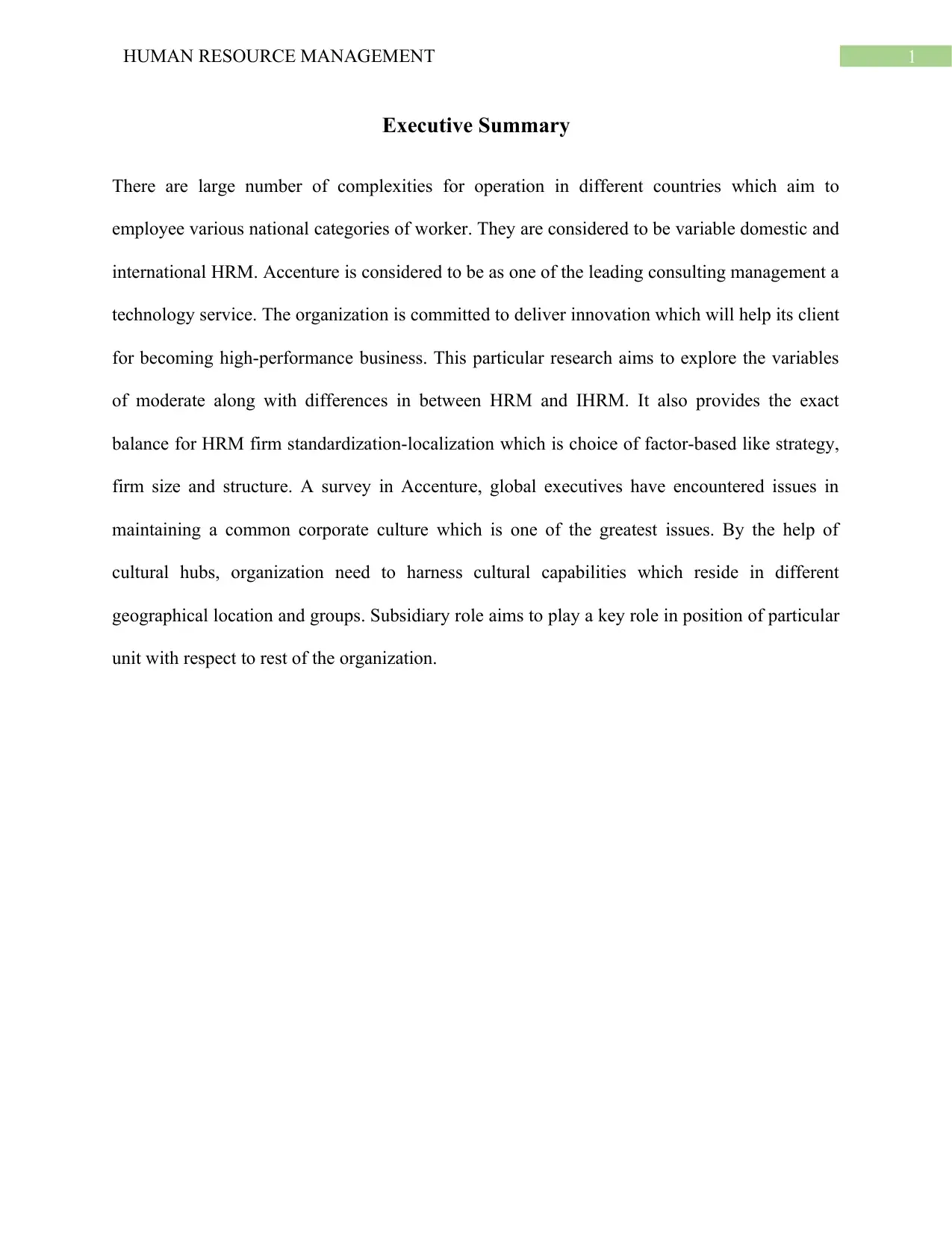
1HUMAN RESOURCE MANAGEMENT
Executive Summary
There are large number of complexities for operation in different countries which aim to
employee various national categories of worker. They are considered to be variable domestic and
international HRM. Accenture is considered to be as one of the leading consulting management a
technology service. The organization is committed to deliver innovation which will help its client
for becoming high-performance business. This particular research aims to explore the variables
of moderate along with differences in between HRM and IHRM. It also provides the exact
balance for HRM firm standardization-localization which is choice of factor-based like strategy,
firm size and structure. A survey in Accenture, global executives have encountered issues in
maintaining a common corporate culture which is one of the greatest issues. By the help of
cultural hubs, organization need to harness cultural capabilities which reside in different
geographical location and groups. Subsidiary role aims to play a key role in position of particular
unit with respect to rest of the organization.
Executive Summary
There are large number of complexities for operation in different countries which aim to
employee various national categories of worker. They are considered to be variable domestic and
international HRM. Accenture is considered to be as one of the leading consulting management a
technology service. The organization is committed to deliver innovation which will help its client
for becoming high-performance business. This particular research aims to explore the variables
of moderate along with differences in between HRM and IHRM. It also provides the exact
balance for HRM firm standardization-localization which is choice of factor-based like strategy,
firm size and structure. A survey in Accenture, global executives have encountered issues in
maintaining a common corporate culture which is one of the greatest issues. By the help of
cultural hubs, organization need to harness cultural capabilities which reside in different
geographical location and groups. Subsidiary role aims to play a key role in position of particular
unit with respect to rest of the organization.
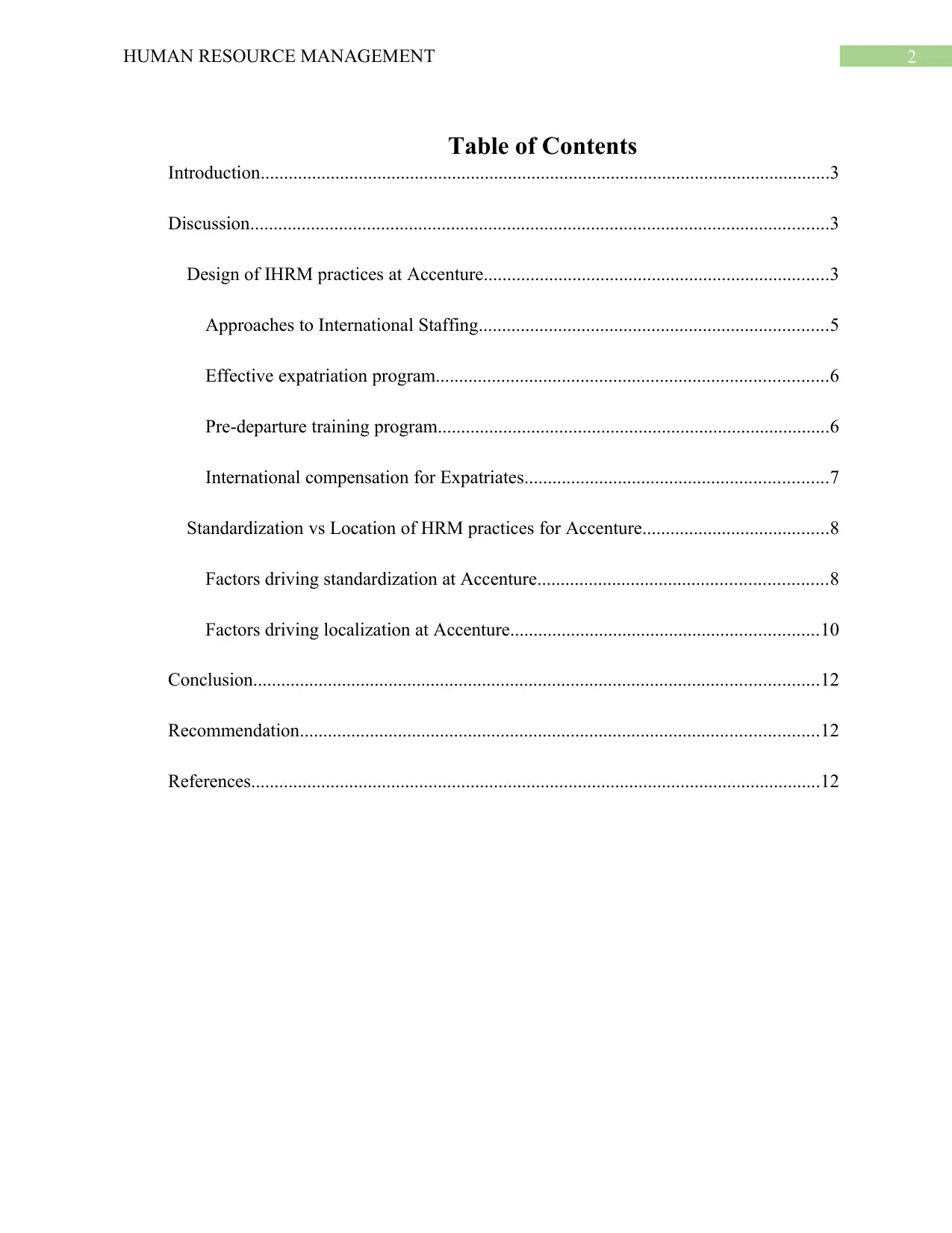
2HUMAN RESOURCE MANAGEMENT
Table of Contents
Introduction..........................................................................................................................3
Discussion............................................................................................................................3
Design of IHRM practices at Accenture..........................................................................3
Approaches to International Staffing...........................................................................5
Effective expatriation program....................................................................................6
Pre-departure training program....................................................................................6
International compensation for Expatriates.................................................................7
Standardization vs Location of HRM practices for Accenture........................................8
Factors driving standardization at Accenture..............................................................8
Factors driving localization at Accenture..................................................................10
Conclusion.........................................................................................................................12
Recommendation...............................................................................................................12
References..........................................................................................................................12
Table of Contents
Introduction..........................................................................................................................3
Discussion............................................................................................................................3
Design of IHRM practices at Accenture..........................................................................3
Approaches to International Staffing...........................................................................5
Effective expatriation program....................................................................................6
Pre-departure training program....................................................................................6
International compensation for Expatriates.................................................................7
Standardization vs Location of HRM practices for Accenture........................................8
Factors driving standardization at Accenture..............................................................8
Factors driving localization at Accenture..................................................................10
Conclusion.........................................................................................................................12
Recommendation...............................................................................................................12
References..........................................................................................................................12
⊘ This is a preview!⊘
Do you want full access?
Subscribe today to unlock all pages.

Trusted by 1+ million students worldwide
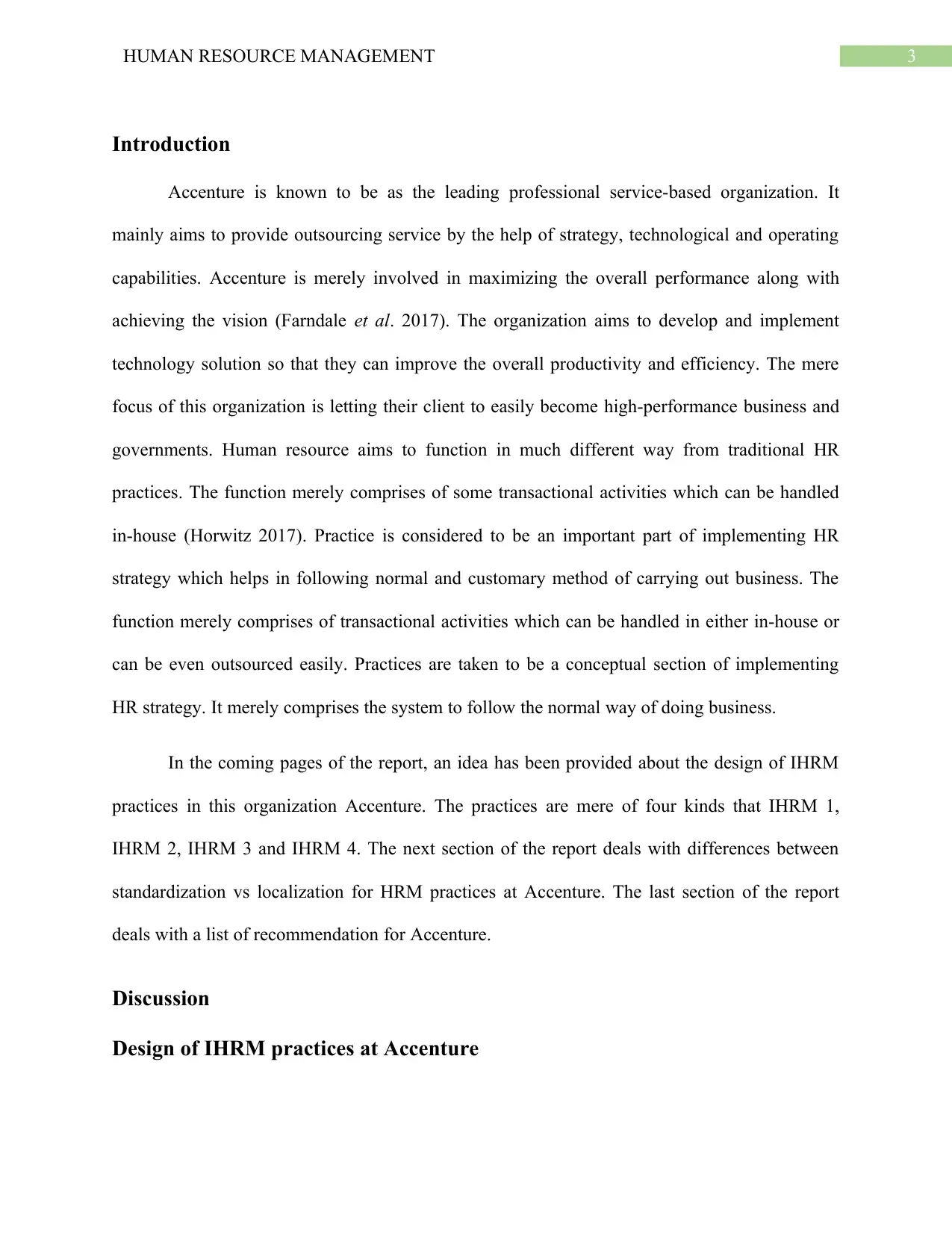
3HUMAN RESOURCE MANAGEMENT
Introduction
Accenture is known to be as the leading professional service-based organization. It
mainly aims to provide outsourcing service by the help of strategy, technological and operating
capabilities. Accenture is merely involved in maximizing the overall performance along with
achieving the vision (Farndale et al. 2017). The organization aims to develop and implement
technology solution so that they can improve the overall productivity and efficiency. The mere
focus of this organization is letting their client to easily become high-performance business and
governments. Human resource aims to function in much different way from traditional HR
practices. The function merely comprises of some transactional activities which can be handled
in-house (Horwitz 2017). Practice is considered to be an important part of implementing HR
strategy which helps in following normal and customary method of carrying out business. The
function merely comprises of transactional activities which can be handled in either in-house or
can be even outsourced easily. Practices are taken to be a conceptual section of implementing
HR strategy. It merely comprises the system to follow the normal way of doing business.
In the coming pages of the report, an idea has been provided about the design of IHRM
practices in this organization Accenture. The practices are mere of four kinds that IHRM 1,
IHRM 2, IHRM 3 and IHRM 4. The next section of the report deals with differences between
standardization vs localization for HRM practices at Accenture. The last section of the report
deals with a list of recommendation for Accenture.
Discussion
Design of IHRM practices at Accenture
Introduction
Accenture is known to be as the leading professional service-based organization. It
mainly aims to provide outsourcing service by the help of strategy, technological and operating
capabilities. Accenture is merely involved in maximizing the overall performance along with
achieving the vision (Farndale et al. 2017). The organization aims to develop and implement
technology solution so that they can improve the overall productivity and efficiency. The mere
focus of this organization is letting their client to easily become high-performance business and
governments. Human resource aims to function in much different way from traditional HR
practices. The function merely comprises of some transactional activities which can be handled
in-house (Horwitz 2017). Practice is considered to be an important part of implementing HR
strategy which helps in following normal and customary method of carrying out business. The
function merely comprises of transactional activities which can be handled in either in-house or
can be even outsourced easily. Practices are taken to be a conceptual section of implementing
HR strategy. It merely comprises the system to follow the normal way of doing business.
In the coming pages of the report, an idea has been provided about the design of IHRM
practices in this organization Accenture. The practices are mere of four kinds that IHRM 1,
IHRM 2, IHRM 3 and IHRM 4. The next section of the report deals with differences between
standardization vs localization for HRM practices at Accenture. The last section of the report
deals with a list of recommendation for Accenture.
Discussion
Design of IHRM practices at Accenture
Paraphrase This Document
Need a fresh take? Get an instant paraphrase of this document with our AI Paraphraser
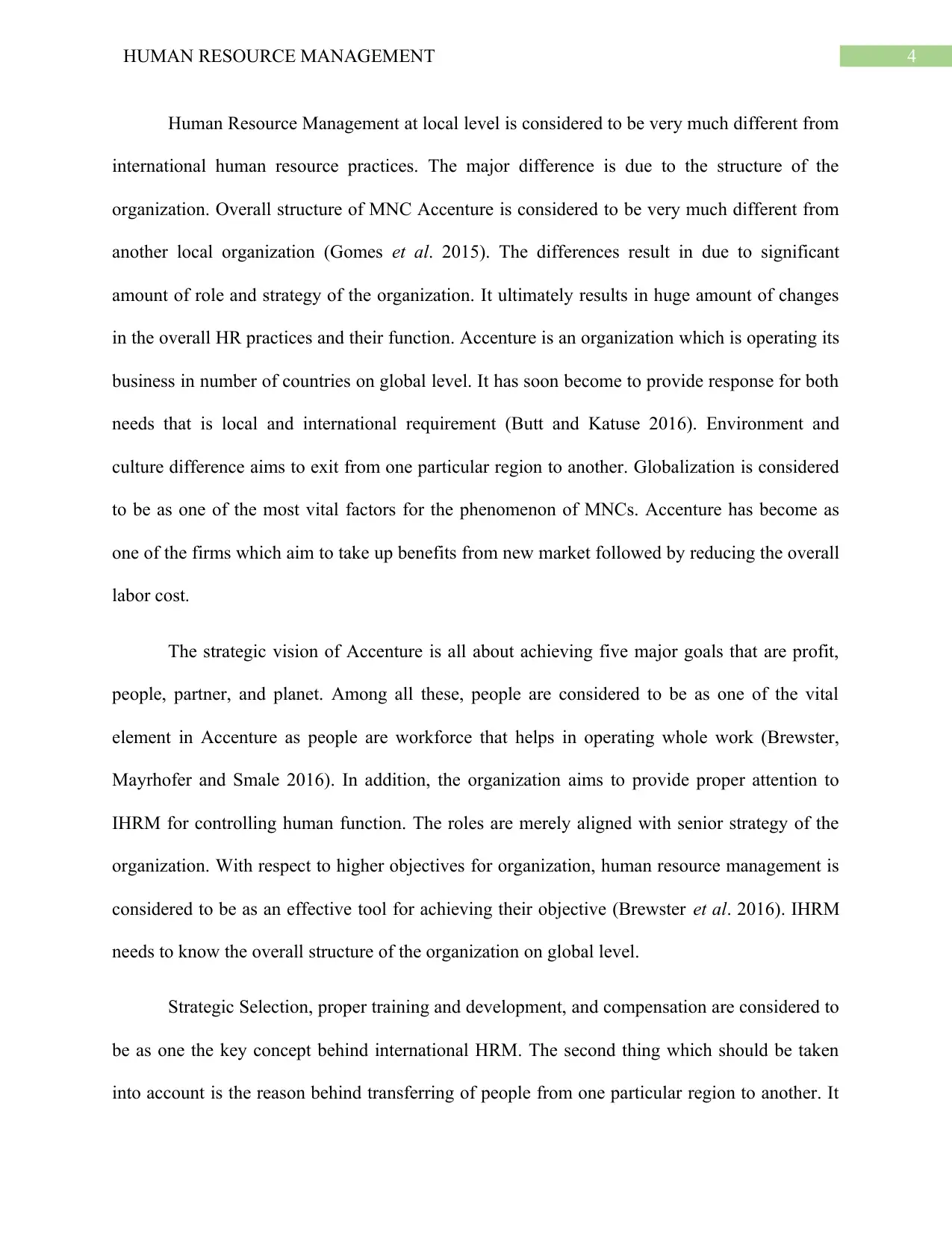
4HUMAN RESOURCE MANAGEMENT
Human Resource Management at local level is considered to be very much different from
international human resource practices. The major difference is due to the structure of the
organization. Overall structure of MNC Accenture is considered to be very much different from
another local organization (Gomes et al. 2015). The differences result in due to significant
amount of role and strategy of the organization. It ultimately results in huge amount of changes
in the overall HR practices and their function. Accenture is an organization which is operating its
business in number of countries on global level. It has soon become to provide response for both
needs that is local and international requirement (Butt and Katuse 2016). Environment and
culture difference aims to exit from one particular region to another. Globalization is considered
to be as one of the most vital factors for the phenomenon of MNCs. Accenture has become as
one of the firms which aim to take up benefits from new market followed by reducing the overall
labor cost.
The strategic vision of Accenture is all about achieving five major goals that are profit,
people, partner, and planet. Among all these, people are considered to be as one of the vital
element in Accenture as people are workforce that helps in operating whole work (Brewster,
Mayrhofer and Smale 2016). In addition, the organization aims to provide proper attention to
IHRM for controlling human function. The roles are merely aligned with senior strategy of the
organization. With respect to higher objectives for organization, human resource management is
considered to be as an effective tool for achieving their objective (Brewster et al. 2016). IHRM
needs to know the overall structure of the organization on global level.
Strategic Selection, proper training and development, and compensation are considered to
be as one the key concept behind international HRM. The second thing which should be taken
into account is the reason behind transferring of people from one particular region to another. It
Human Resource Management at local level is considered to be very much different from
international human resource practices. The major difference is due to the structure of the
organization. Overall structure of MNC Accenture is considered to be very much different from
another local organization (Gomes et al. 2015). The differences result in due to significant
amount of role and strategy of the organization. It ultimately results in huge amount of changes
in the overall HR practices and their function. Accenture is an organization which is operating its
business in number of countries on global level. It has soon become to provide response for both
needs that is local and international requirement (Butt and Katuse 2016). Environment and
culture difference aims to exit from one particular region to another. Globalization is considered
to be as one of the most vital factors for the phenomenon of MNCs. Accenture has become as
one of the firms which aim to take up benefits from new market followed by reducing the overall
labor cost.
The strategic vision of Accenture is all about achieving five major goals that are profit,
people, partner, and planet. Among all these, people are considered to be as one of the vital
element in Accenture as people are workforce that helps in operating whole work (Brewster,
Mayrhofer and Smale 2016). In addition, the organization aims to provide proper attention to
IHRM for controlling human function. The roles are merely aligned with senior strategy of the
organization. With respect to higher objectives for organization, human resource management is
considered to be as an effective tool for achieving their objective (Brewster et al. 2016). IHRM
needs to know the overall structure of the organization on global level.
Strategic Selection, proper training and development, and compensation are considered to
be as one the key concept behind international HRM. The second thing which should be taken
into account is the reason behind transferring of people from one particular region to another. It
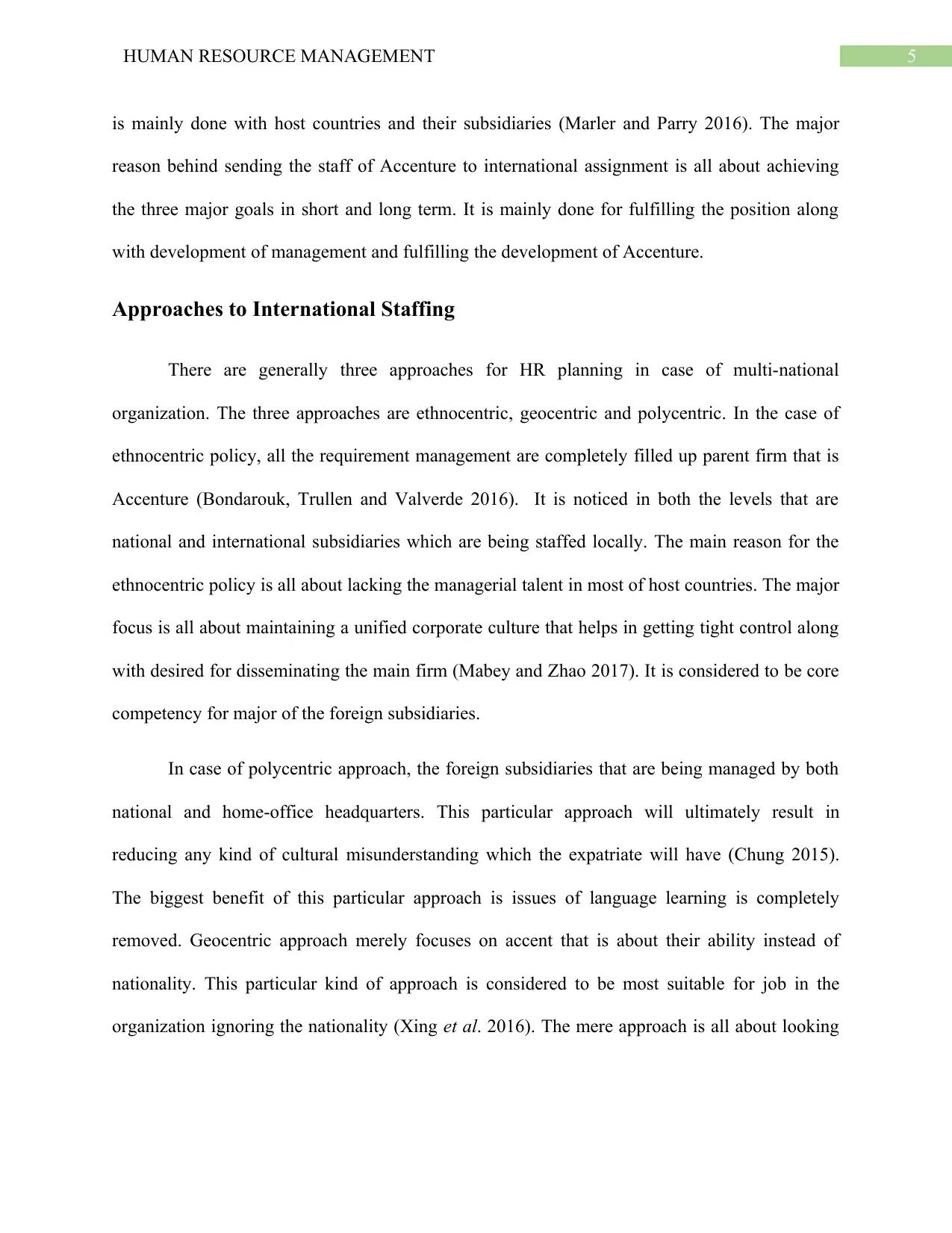
5HUMAN RESOURCE MANAGEMENT
is mainly done with host countries and their subsidiaries (Marler and Parry 2016). The major
reason behind sending the staff of Accenture to international assignment is all about achieving
the three major goals in short and long term. It is mainly done for fulfilling the position along
with development of management and fulfilling the development of Accenture.
Approaches to International Staffing
There are generally three approaches for HR planning in case of multi-national
organization. The three approaches are ethnocentric, geocentric and polycentric. In the case of
ethnocentric policy, all the requirement management are completely filled up parent firm that is
Accenture (Bondarouk, Trullen and Valverde 2016). It is noticed in both the levels that are
national and international subsidiaries which are being staffed locally. The main reason for the
ethnocentric policy is all about lacking the managerial talent in most of host countries. The major
focus is all about maintaining a unified corporate culture that helps in getting tight control along
with desired for disseminating the main firm (Mabey and Zhao 2017). It is considered to be core
competency for major of the foreign subsidiaries.
In case of polycentric approach, the foreign subsidiaries that are being managed by both
national and home-office headquarters. This particular approach will ultimately result in
reducing any kind of cultural misunderstanding which the expatriate will have (Chung 2015).
The biggest benefit of this particular approach is issues of language learning is completely
removed. Geocentric approach merely focuses on accent that is about their ability instead of
nationality. This particular kind of approach is considered to be most suitable for job in the
organization ignoring the nationality (Xing et al. 2016). The mere approach is all about looking
is mainly done with host countries and their subsidiaries (Marler and Parry 2016). The major
reason behind sending the staff of Accenture to international assignment is all about achieving
the three major goals in short and long term. It is mainly done for fulfilling the position along
with development of management and fulfilling the development of Accenture.
Approaches to International Staffing
There are generally three approaches for HR planning in case of multi-national
organization. The three approaches are ethnocentric, geocentric and polycentric. In the case of
ethnocentric policy, all the requirement management are completely filled up parent firm that is
Accenture (Bondarouk, Trullen and Valverde 2016). It is noticed in both the levels that are
national and international subsidiaries which are being staffed locally. The main reason for the
ethnocentric policy is all about lacking the managerial talent in most of host countries. The major
focus is all about maintaining a unified corporate culture that helps in getting tight control along
with desired for disseminating the main firm (Mabey and Zhao 2017). It is considered to be core
competency for major of the foreign subsidiaries.
In case of polycentric approach, the foreign subsidiaries that are being managed by both
national and home-office headquarters. This particular approach will ultimately result in
reducing any kind of cultural misunderstanding which the expatriate will have (Chung 2015).
The biggest benefit of this particular approach is issues of language learning is completely
removed. Geocentric approach merely focuses on accent that is about their ability instead of
nationality. This particular kind of approach is considered to be most suitable for job in the
organization ignoring the nationality (Xing et al. 2016). The mere approach is all about looking
⊘ This is a preview!⊘
Do you want full access?
Subscribe today to unlock all pages.

Trusted by 1+ million students worldwide
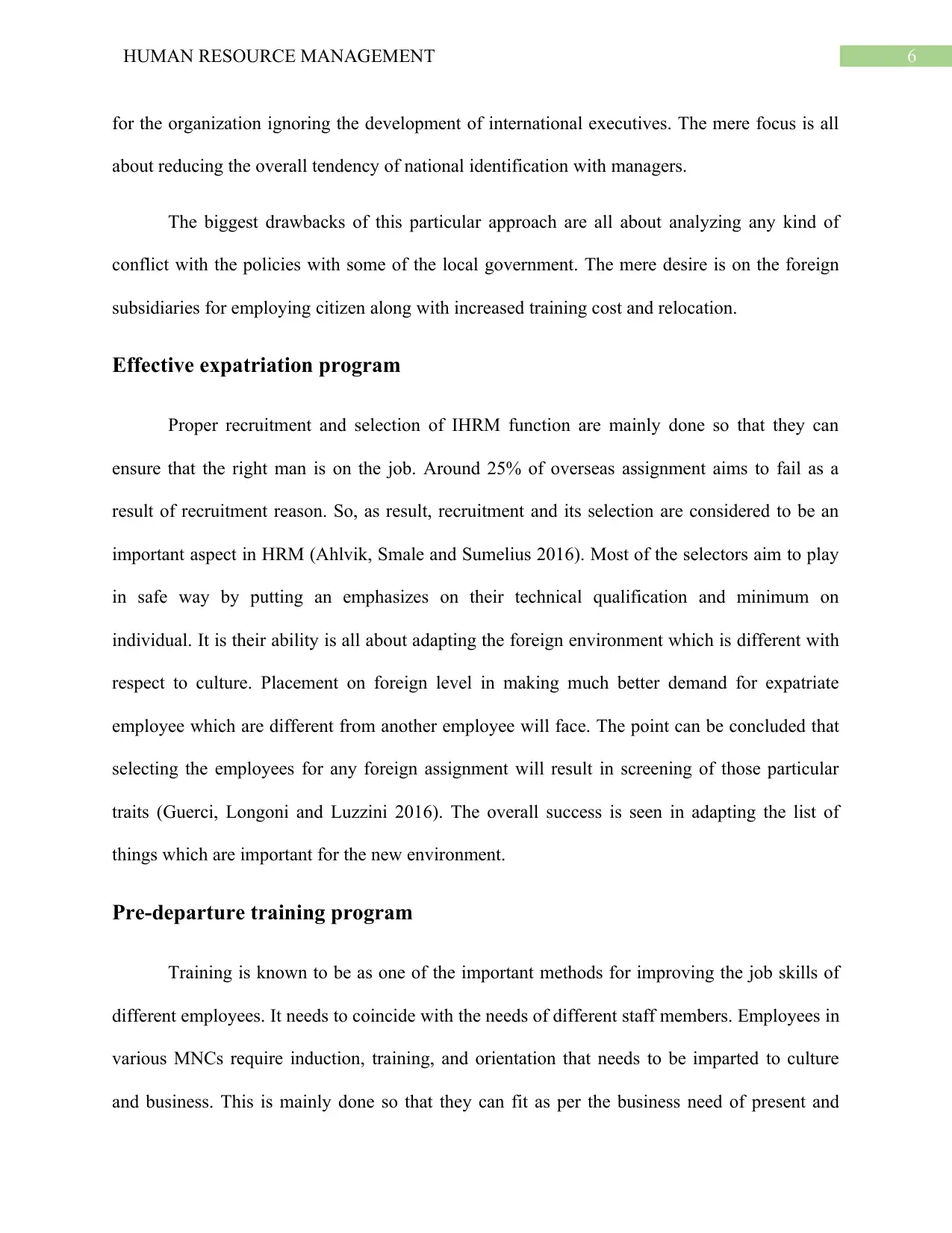
6HUMAN RESOURCE MANAGEMENT
for the organization ignoring the development of international executives. The mere focus is all
about reducing the overall tendency of national identification with managers.
The biggest drawbacks of this particular approach are all about analyzing any kind of
conflict with the policies with some of the local government. The mere desire is on the foreign
subsidiaries for employing citizen along with increased training cost and relocation.
Effective expatriation program
Proper recruitment and selection of IHRM function are mainly done so that they can
ensure that the right man is on the job. Around 25% of overseas assignment aims to fail as a
result of recruitment reason. So, as result, recruitment and its selection are considered to be an
important aspect in HRM (Ahlvik, Smale and Sumelius 2016). Most of the selectors aim to play
in safe way by putting an emphasizes on their technical qualification and minimum on
individual. It is their ability is all about adapting the foreign environment which is different with
respect to culture. Placement on foreign level in making much better demand for expatriate
employee which are different from another employee will face. The point can be concluded that
selecting the employees for any foreign assignment will result in screening of those particular
traits (Guerci, Longoni and Luzzini 2016). The overall success is seen in adapting the list of
things which are important for the new environment.
Pre-departure training program
Training is known to be as one of the important methods for improving the job skills of
different employees. It needs to coincide with the needs of different staff members. Employees in
various MNCs require induction, training, and orientation that needs to be imparted to culture
and business. This is mainly done so that they can fit as per the business need of present and
for the organization ignoring the development of international executives. The mere focus is all
about reducing the overall tendency of national identification with managers.
The biggest drawbacks of this particular approach are all about analyzing any kind of
conflict with the policies with some of the local government. The mere desire is on the foreign
subsidiaries for employing citizen along with increased training cost and relocation.
Effective expatriation program
Proper recruitment and selection of IHRM function are mainly done so that they can
ensure that the right man is on the job. Around 25% of overseas assignment aims to fail as a
result of recruitment reason. So, as result, recruitment and its selection are considered to be an
important aspect in HRM (Ahlvik, Smale and Sumelius 2016). Most of the selectors aim to play
in safe way by putting an emphasizes on their technical qualification and minimum on
individual. It is their ability is all about adapting the foreign environment which is different with
respect to culture. Placement on foreign level in making much better demand for expatriate
employee which are different from another employee will face. The point can be concluded that
selecting the employees for any foreign assignment will result in screening of those particular
traits (Guerci, Longoni and Luzzini 2016). The overall success is seen in adapting the list of
things which are important for the new environment.
Pre-departure training program
Training is known to be as one of the important methods for improving the job skills of
different employees. It needs to coincide with the needs of different staff members. Employees in
various MNCs require induction, training, and orientation that needs to be imparted to culture
and business. This is mainly done so that they can fit as per the business need of present and
Paraphrase This Document
Need a fresh take? Get an instant paraphrase of this document with our AI Paraphraser

7HUMAN RESOURCE MANAGEMENT
upcoming days (Bannò and Sgobbi, 2016). Overseas employees emphasize that employees
require four levels of training that needs to be imparted.
Level 1: This particular level of training focuses on the overall impact for cultural
difference which can raise training awareness for this kind of differences. In addition, there is
need for analyzing the impact of each of the business outcomes.
Level 2: This particular level focus on getting the aims and attitude being positive and
negatives are easily formed along with understanding their influence on behavior.
Level 3: This training will provide proper knowledge about the target firm.
Level 4: It focuses on some of the areas like skill-building like adjustment and language.
Apart from special training-based practices, there is requirement of some traditional
method of training which is needed for development of oversea employees.
International compensation for Expatriates
Issues with respect to international employees are considered to be tricky because of two
major reasons. The first thing is that paying for employees of first rank can have compensation
which satisfies the proper norm of remuneration. It creates much more issue than what it aims to
solve (Gannon, Roper and Doherty 2015). The second thing that should be taken into
consideration is that overall cost of living tends to vary to large extent in most of the countries.
The most common kind of approach is all about formulating the employees with compensation
for equating with purchasing power in most of the countries. There is particular approach which
is defined as balance sheet approach. The mere focus of this approach is that most of the foreign
employees are provided with same standard of living which they have enjoyed at home (Kirk
upcoming days (Bannò and Sgobbi, 2016). Overseas employees emphasize that employees
require four levels of training that needs to be imparted.
Level 1: This particular level of training focuses on the overall impact for cultural
difference which can raise training awareness for this kind of differences. In addition, there is
need for analyzing the impact of each of the business outcomes.
Level 2: This particular level focus on getting the aims and attitude being positive and
negatives are easily formed along with understanding their influence on behavior.
Level 3: This training will provide proper knowledge about the target firm.
Level 4: It focuses on some of the areas like skill-building like adjustment and language.
Apart from special training-based practices, there is requirement of some traditional
method of training which is needed for development of oversea employees.
International compensation for Expatriates
Issues with respect to international employees are considered to be tricky because of two
major reasons. The first thing is that paying for employees of first rank can have compensation
which satisfies the proper norm of remuneration. It creates much more issue than what it aims to
solve (Gannon, Roper and Doherty 2015). The second thing that should be taken into
consideration is that overall cost of living tends to vary to large extent in most of the countries.
The most common kind of approach is all about formulating the employees with compensation
for equating with purchasing power in most of the countries. There is particular approach which
is defined as balance sheet approach. The mere focus of this approach is that most of the foreign
employees are provided with same standard of living which they have enjoyed at home (Kirk
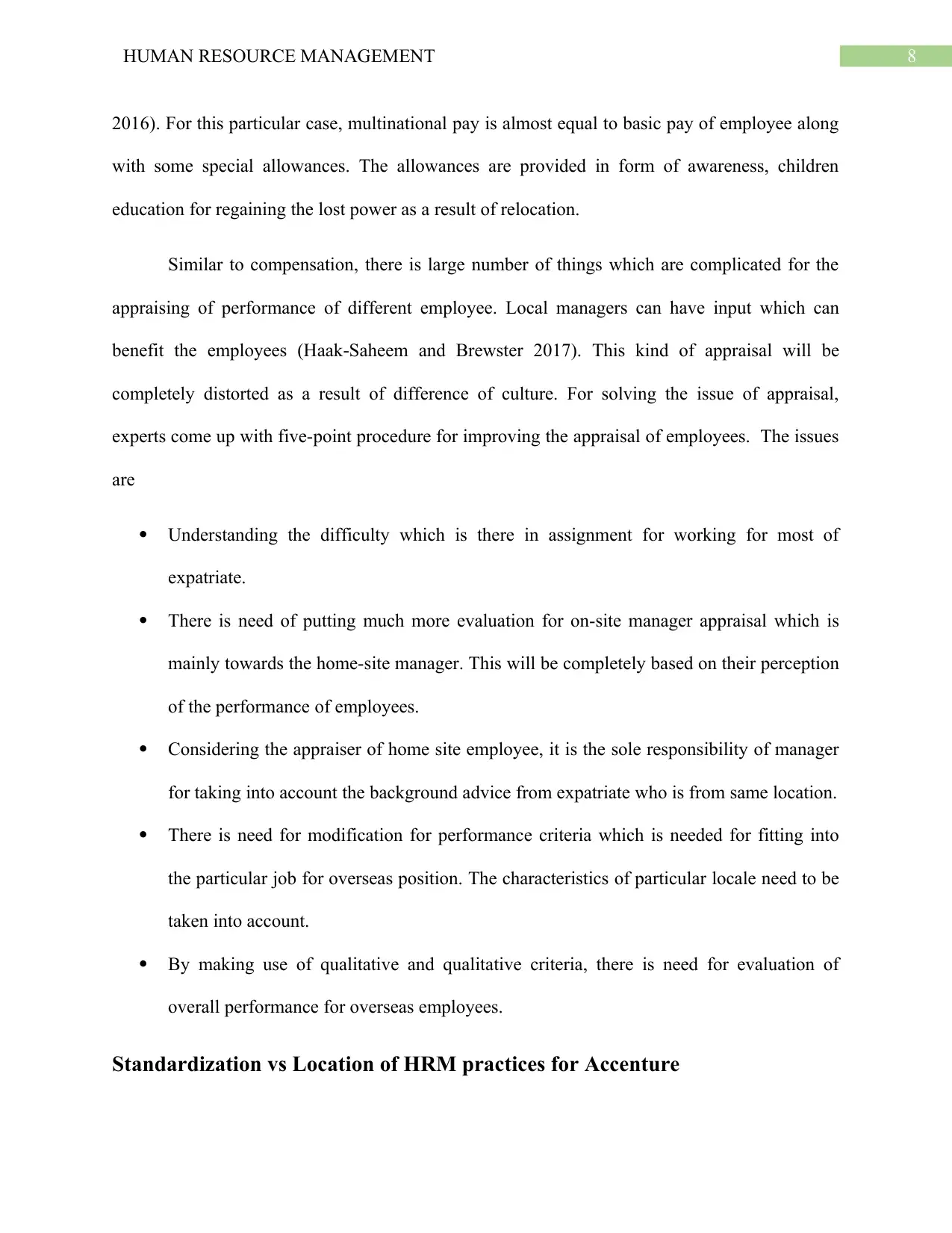
8HUMAN RESOURCE MANAGEMENT
2016). For this particular case, multinational pay is almost equal to basic pay of employee along
with some special allowances. The allowances are provided in form of awareness, children
education for regaining the lost power as a result of relocation.
Similar to compensation, there is large number of things which are complicated for the
appraising of performance of different employee. Local managers can have input which can
benefit the employees (Haak Saheem and Brewster 2017). This kind of appraisal will be‐
completely distorted as a result of difference of culture. For solving the issue of appraisal,
experts come up with five-point procedure for improving the appraisal of employees. The issues
are
Understanding the difficulty which is there in assignment for working for most of
expatriate.
There is need of putting much more evaluation for on-site manager appraisal which is
mainly towards the home-site manager. This will be completely based on their perception
of the performance of employees.
Considering the appraiser of home site employee, it is the sole responsibility of manager
for taking into account the background advice from expatriate who is from same location.
There is need for modification for performance criteria which is needed for fitting into
the particular job for overseas position. The characteristics of particular locale need to be
taken into account.
By making use of qualitative and qualitative criteria, there is need for evaluation of
overall performance for overseas employees.
Standardization vs Location of HRM practices for Accenture
2016). For this particular case, multinational pay is almost equal to basic pay of employee along
with some special allowances. The allowances are provided in form of awareness, children
education for regaining the lost power as a result of relocation.
Similar to compensation, there is large number of things which are complicated for the
appraising of performance of different employee. Local managers can have input which can
benefit the employees (Haak Saheem and Brewster 2017). This kind of appraisal will be‐
completely distorted as a result of difference of culture. For solving the issue of appraisal,
experts come up with five-point procedure for improving the appraisal of employees. The issues
are
Understanding the difficulty which is there in assignment for working for most of
expatriate.
There is need of putting much more evaluation for on-site manager appraisal which is
mainly towards the home-site manager. This will be completely based on their perception
of the performance of employees.
Considering the appraiser of home site employee, it is the sole responsibility of manager
for taking into account the background advice from expatriate who is from same location.
There is need for modification for performance criteria which is needed for fitting into
the particular job for overseas position. The characteristics of particular locale need to be
taken into account.
By making use of qualitative and qualitative criteria, there is need for evaluation of
overall performance for overseas employees.
Standardization vs Location of HRM practices for Accenture
⊘ This is a preview!⊘
Do you want full access?
Subscribe today to unlock all pages.

Trusted by 1+ million students worldwide
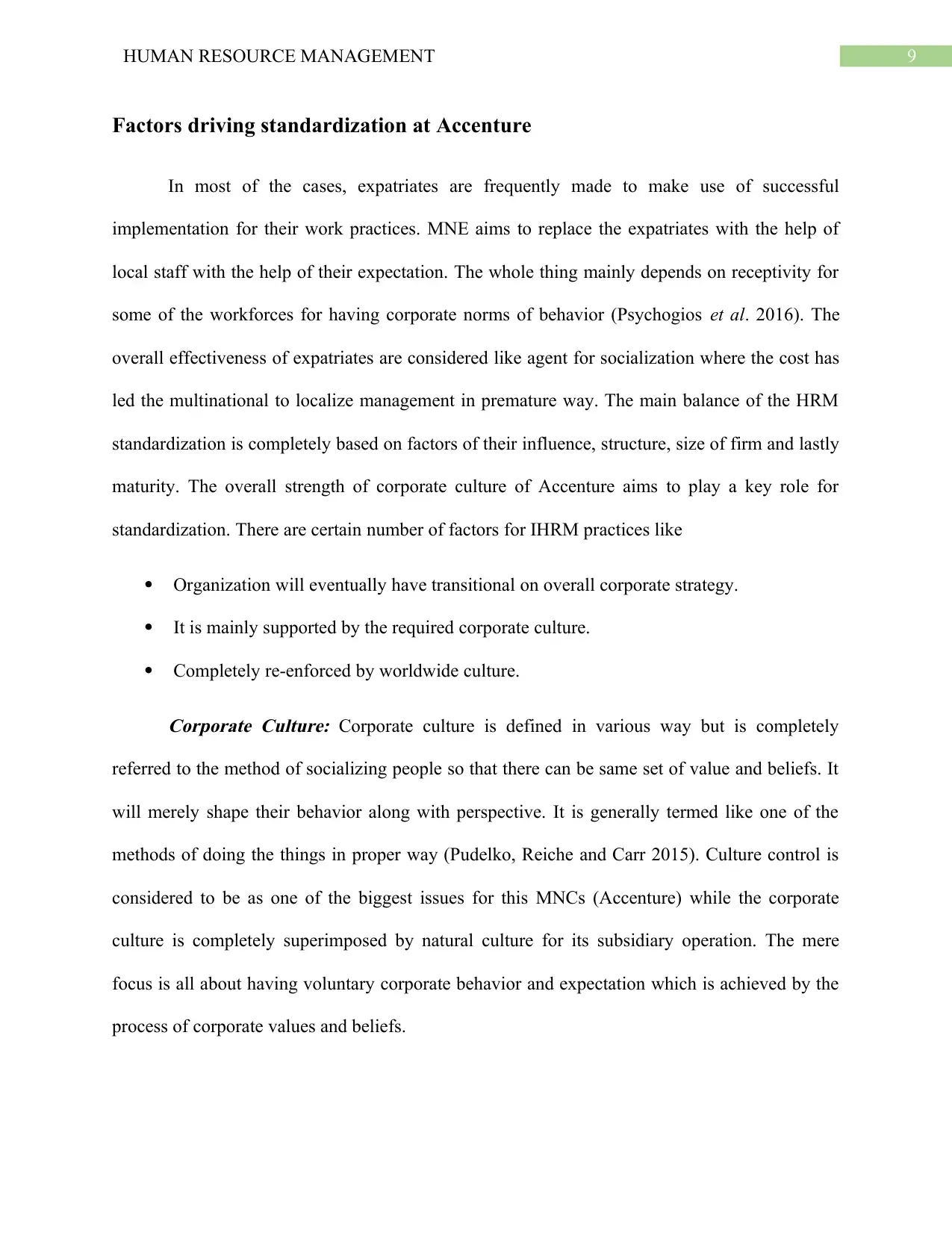
9HUMAN RESOURCE MANAGEMENT
Factors driving standardization at Accenture
In most of the cases, expatriates are frequently made to make use of successful
implementation for their work practices. MNE aims to replace the expatriates with the help of
local staff with the help of their expectation. The whole thing mainly depends on receptivity for
some of the workforces for having corporate norms of behavior (Psychogios et al. 2016). The
overall effectiveness of expatriates are considered like agent for socialization where the cost has
led the multinational to localize management in premature way. The main balance of the HRM
standardization is completely based on factors of their influence, structure, size of firm and lastly
maturity. The overall strength of corporate culture of Accenture aims to play a key role for
standardization. There are certain number of factors for IHRM practices like
Organization will eventually have transitional on overall corporate strategy.
It is mainly supported by the required corporate culture.
Completely re-enforced by worldwide culture.
Corporate Culture: Corporate culture is defined in various way but is completely
referred to the method of socializing people so that there can be same set of value and beliefs. It
will merely shape their behavior along with perspective. It is generally termed like one of the
methods of doing the things in proper way (Pudelko, Reiche and Carr 2015). Culture control is
considered to be as one of the biggest issues for this MNCs (Accenture) while the corporate
culture is completely superimposed by natural culture for its subsidiary operation. The mere
focus is all about having voluntary corporate behavior and expectation which is achieved by the
process of corporate values and beliefs.
Factors driving standardization at Accenture
In most of the cases, expatriates are frequently made to make use of successful
implementation for their work practices. MNE aims to replace the expatriates with the help of
local staff with the help of their expectation. The whole thing mainly depends on receptivity for
some of the workforces for having corporate norms of behavior (Psychogios et al. 2016). The
overall effectiveness of expatriates are considered like agent for socialization where the cost has
led the multinational to localize management in premature way. The main balance of the HRM
standardization is completely based on factors of their influence, structure, size of firm and lastly
maturity. The overall strength of corporate culture of Accenture aims to play a key role for
standardization. There are certain number of factors for IHRM practices like
Organization will eventually have transitional on overall corporate strategy.
It is mainly supported by the required corporate culture.
Completely re-enforced by worldwide culture.
Corporate Culture: Corporate culture is defined in various way but is completely
referred to the method of socializing people so that there can be same set of value and beliefs. It
will merely shape their behavior along with perspective. It is generally termed like one of the
methods of doing the things in proper way (Pudelko, Reiche and Carr 2015). Culture control is
considered to be as one of the biggest issues for this MNCs (Accenture) while the corporate
culture is completely superimposed by natural culture for its subsidiary operation. The mere
focus is all about having voluntary corporate behavior and expectation which is achieved by the
process of corporate values and beliefs.
Paraphrase This Document
Need a fresh take? Get an instant paraphrase of this document with our AI Paraphraser
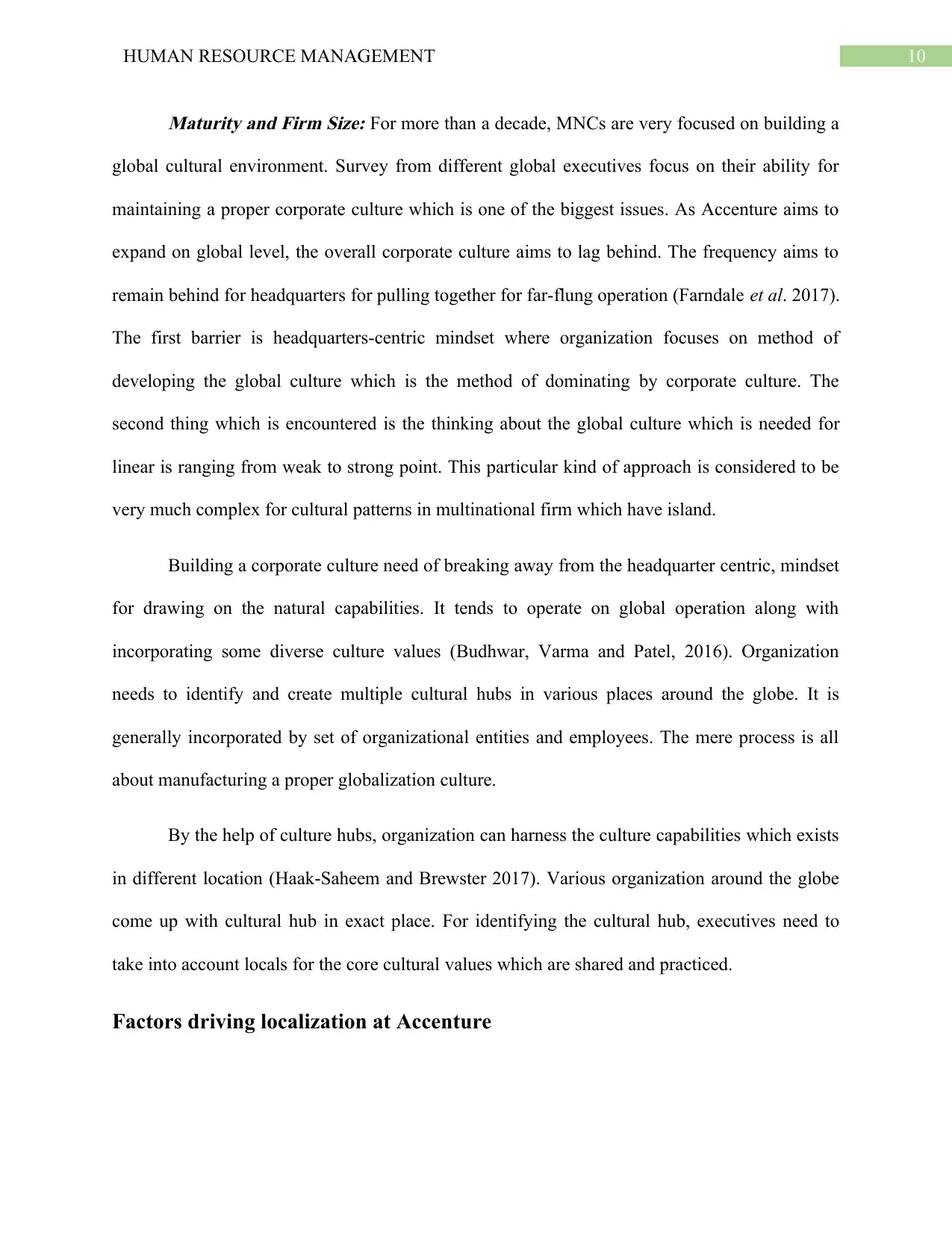
10HUMAN RESOURCE MANAGEMENT
Maturity and Firm Size: For more than a decade, MNCs are very focused on building a
global cultural environment. Survey from different global executives focus on their ability for
maintaining a proper corporate culture which is one of the biggest issues. As Accenture aims to
expand on global level, the overall corporate culture aims to lag behind. The frequency aims to
remain behind for headquarters for pulling together for far-flung operation (Farndale et al. 2017).
The first barrier is headquarters-centric mindset where organization focuses on method of
developing the global culture which is the method of dominating by corporate culture. The
second thing which is encountered is the thinking about the global culture which is needed for
linear is ranging from weak to strong point. This particular kind of approach is considered to be
very much complex for cultural patterns in multinational firm which have island.
Building a corporate culture need of breaking away from the headquarter centric, mindset
for drawing on the natural capabilities. It tends to operate on global operation along with
incorporating some diverse culture values (Budhwar, Varma and Patel, 2016). Organization
needs to identify and create multiple cultural hubs in various places around the globe. It is
generally incorporated by set of organizational entities and employees. The mere process is all
about manufacturing a proper globalization culture.
By the help of culture hubs, organization can harness the culture capabilities which exists
in different location (Haak Saheem and Brewster 2017). Various organization around the globe‐
come up with cultural hub in exact place. For identifying the cultural hub, executives need to
take into account locals for the core cultural values which are shared and practiced.
Factors driving localization at Accenture
Maturity and Firm Size: For more than a decade, MNCs are very focused on building a
global cultural environment. Survey from different global executives focus on their ability for
maintaining a proper corporate culture which is one of the biggest issues. As Accenture aims to
expand on global level, the overall corporate culture aims to lag behind. The frequency aims to
remain behind for headquarters for pulling together for far-flung operation (Farndale et al. 2017).
The first barrier is headquarters-centric mindset where organization focuses on method of
developing the global culture which is the method of dominating by corporate culture. The
second thing which is encountered is the thinking about the global culture which is needed for
linear is ranging from weak to strong point. This particular kind of approach is considered to be
very much complex for cultural patterns in multinational firm which have island.
Building a corporate culture need of breaking away from the headquarter centric, mindset
for drawing on the natural capabilities. It tends to operate on global operation along with
incorporating some diverse culture values (Budhwar, Varma and Patel, 2016). Organization
needs to identify and create multiple cultural hubs in various places around the globe. It is
generally incorporated by set of organizational entities and employees. The mere process is all
about manufacturing a proper globalization culture.
By the help of culture hubs, organization can harness the culture capabilities which exists
in different location (Haak Saheem and Brewster 2017). Various organization around the globe‐
come up with cultural hub in exact place. For identifying the cultural hub, executives need to
take into account locals for the core cultural values which are shared and practiced.
Factors driving localization at Accenture
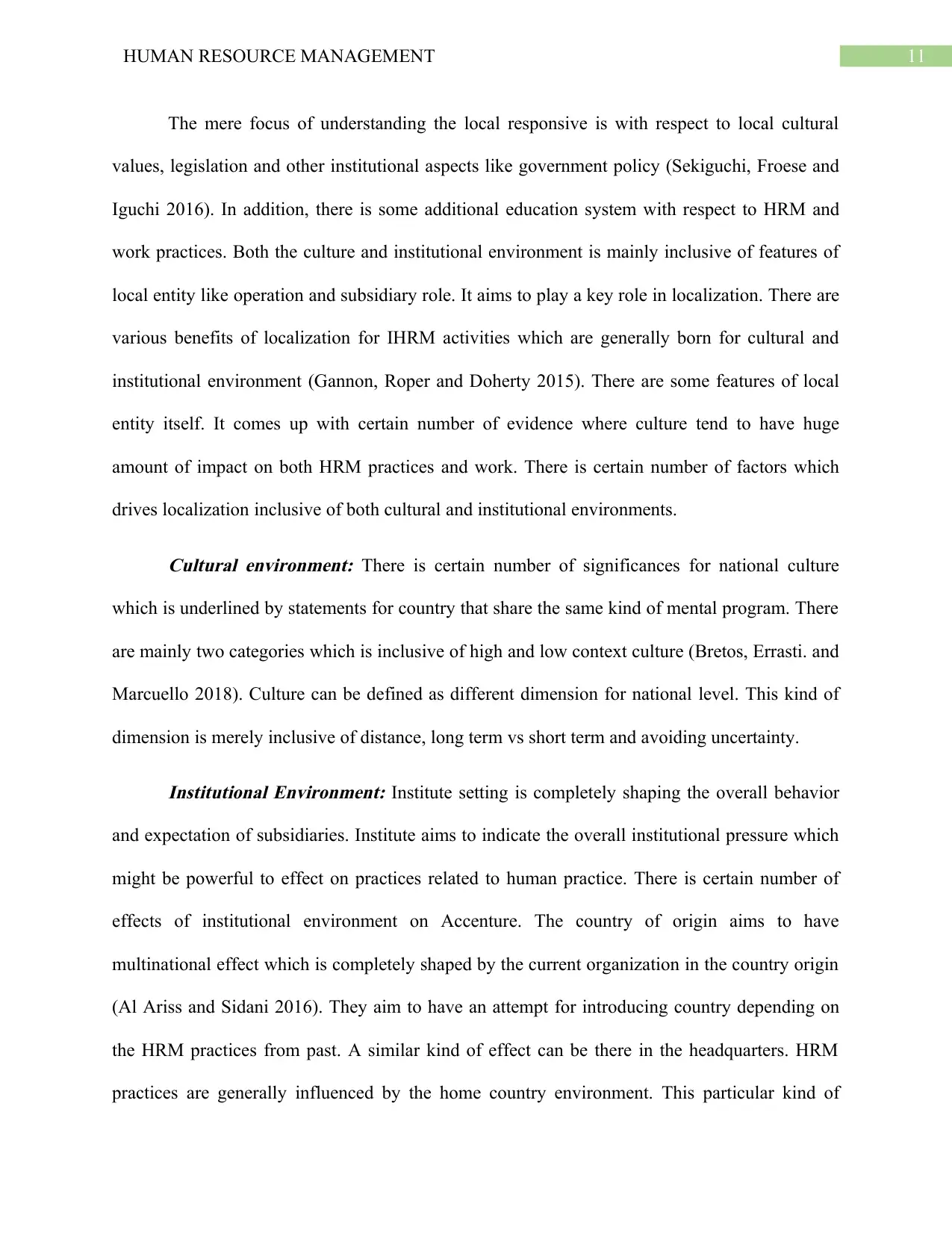
11HUMAN RESOURCE MANAGEMENT
The mere focus of understanding the local responsive is with respect to local cultural
values, legislation and other institutional aspects like government policy (Sekiguchi, Froese and
Iguchi 2016). In addition, there is some additional education system with respect to HRM and
work practices. Both the culture and institutional environment is mainly inclusive of features of
local entity like operation and subsidiary role. It aims to play a key role in localization. There are
various benefits of localization for IHRM activities which are generally born for cultural and
institutional environment (Gannon, Roper and Doherty 2015). There are some features of local
entity itself. It comes up with certain number of evidence where culture tend to have huge
amount of impact on both HRM practices and work. There is certain number of factors which
drives localization inclusive of both cultural and institutional environments.
Cultural environment: There is certain number of significances for national culture
which is underlined by statements for country that share the same kind of mental program. There
are mainly two categories which is inclusive of high and low context culture (Bretos, Errasti. and
Marcuello 2018). Culture can be defined as different dimension for national level. This kind of
dimension is merely inclusive of distance, long term vs short term and avoiding uncertainty.
Institutional Environment: Institute setting is completely shaping the overall behavior
and expectation of subsidiaries. Institute aims to indicate the overall institutional pressure which
might be powerful to effect on practices related to human practice. There is certain number of
effects of institutional environment on Accenture. The country of origin aims to have
multinational effect which is completely shaped by the current organization in the country origin
(Al Ariss and Sidani 2016). They aim to have an attempt for introducing country depending on
the HRM practices from past. A similar kind of effect can be there in the headquarters. HRM
practices are generally influenced by the home country environment. This particular kind of
The mere focus of understanding the local responsive is with respect to local cultural
values, legislation and other institutional aspects like government policy (Sekiguchi, Froese and
Iguchi 2016). In addition, there is some additional education system with respect to HRM and
work practices. Both the culture and institutional environment is mainly inclusive of features of
local entity like operation and subsidiary role. It aims to play a key role in localization. There are
various benefits of localization for IHRM activities which are generally born for cultural and
institutional environment (Gannon, Roper and Doherty 2015). There are some features of local
entity itself. It comes up with certain number of evidence where culture tend to have huge
amount of impact on both HRM practices and work. There is certain number of factors which
drives localization inclusive of both cultural and institutional environments.
Cultural environment: There is certain number of significances for national culture
which is underlined by statements for country that share the same kind of mental program. There
are mainly two categories which is inclusive of high and low context culture (Bretos, Errasti. and
Marcuello 2018). Culture can be defined as different dimension for national level. This kind of
dimension is merely inclusive of distance, long term vs short term and avoiding uncertainty.
Institutional Environment: Institute setting is completely shaping the overall behavior
and expectation of subsidiaries. Institute aims to indicate the overall institutional pressure which
might be powerful to effect on practices related to human practice. There is certain number of
effects of institutional environment on Accenture. The country of origin aims to have
multinational effect which is completely shaped by the current organization in the country origin
(Al Ariss and Sidani 2016). They aim to have an attempt for introducing country depending on
the HRM practices from past. A similar kind of effect can be there in the headquarters. HRM
practices are generally influenced by the home country environment. This particular kind of
⊘ This is a preview!⊘
Do you want full access?
Subscribe today to unlock all pages.

Trusted by 1+ million students worldwide
1 out of 18
Related Documents
Your All-in-One AI-Powered Toolkit for Academic Success.
+13062052269
info@desklib.com
Available 24*7 on WhatsApp / Email
![[object Object]](/_next/static/media/star-bottom.7253800d.svg)
Unlock your academic potential
Copyright © 2020–2025 A2Z Services. All Rights Reserved. Developed and managed by ZUCOL.





